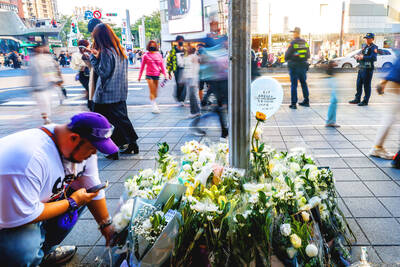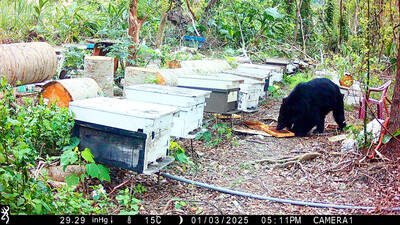A recent Japanese report revealing a dramatic decline in traffic-related fatalities last year indicates that a strict seatbelt bill that failed to clear the Legislative Yuan in 2006 would still promote improved traffic safety in Taiwan, a transportation official said yesterday.
FINES
The statistical report issued on Friday in Japan attributed the reduction in traffic deaths to harsher fines for traffic violations and tighter seatbelt regulations that required passengers in the back seats of vehicles to buckle up.
Yin Cheng-peng (尹承蓬), director of the Ministry of Transportation and Communications’ (MOTC) Department of Aviation and Navigation, said that Taiwan promoted similar legislation in 2005, but it failed to get through the legislature in 2006 because of concerns the rear seatbelt could strangle young children.
Yin, who at the time was the deputy director of the Department of Railways and Highways and the government’s point man on the failed seatbelt bill, said that promoting rear seatbelts might still be desirable.
PROTECTION
Though the correlation between rear seatbelts and traffic fatalities is still being studied, Yin said the MOTC would be in favor of another layer of protection to keep passengers in the back seats of vehicles from being ejected from cars in an accident.
Recalling the legislative campaign to promote the seatbelt bill, Yin said former Democratic Progressive Party legislator Chen Chao-lung (陳朝龍) proposed legislation in 2005 that would make rear seatbelts compulsory.
But it was not until a high-profile accident in late 2006 that the bill made it onto the legislative agenda, he said.
JASON HU
Taichung Mayor Jason Hu’s (胡志強) wife, Shirley Shaw (邵曉鈴), was nearly killed in a freeway accident after being thrown from the back seat of the vehicle in mid-November 2006.
She eventually lost her spleen and had her forearm amputated.
The accident got the bill onto the agenda of the legislature’s Transportation Committee, which then approved it and sent it to the full legislature for a vote.
The bill stalled in its second reading, however, with several lawmakers concerned rear seatbelts might harm small children.

SHIPS, TRAINS AND AUTOMOBILES: The ministry has announced changes to varied transportation industries taking effect soon, with a number of effects for passengers Beginning next month, the post office is canceling signature upon delivery and written inquiry services for international registered small packets in accordance with the new policy of the Universal Postal Union, the Ministry of Transportation and Communications said yesterday. The new policy does not apply to packets that are to be delivered to China, the ministry said. Senders of international registered small packets would receive a NT$10 rebate on postage if the packets are sent from Jan. 1 to March 31, it added. The ministry said that three other policies are also scheduled to take effect next month. International cruise ship operators

HORROR STORIES: One victim recounted not realizing they had been stabbed and seeing people bleeding, while another recalled breaking down in tears after fleeing A man on Friday died after he tried to fight the knife-wielding suspect who went on a stabbing spree near two of Taipei’s busiest metro stations, Taipei Mayor Chiang Wan-an (蔣萬安) said. The 57-year-old man, identified by his family name, Yu (余), encountered the suspect at Exit M7 of Taipei Main Station and immediately tried to stop him, but was fatally wounded and later died, Chiang said, calling the incident “heartbreaking.” Yu’s family would receive at least NT$5 million (US$158,584) in compensation through the Taipei Rapid Transit Corp’s (TRTC) insurance coverage, he said after convening an emergency security response meeting yesterday morning. National

PLANNED: The suspect visited the crime scene before the killings, seeking information on how to access the roof, and had extensively researched a 2014 stabbing incident The suspect in a stabbing attack that killed three people and injured 11 in Taipei on Friday had planned the assault and set fires at other locations earlier in the day, law enforcement officials said yesterday. National Police Agency (NPA) Director-General Chang Jung-hsin (張榮興) said the suspect, a 27-year-old man named Chang Wen (張文), began the attacks at 3:40pm, first setting off smoke bombs on a road, damaging cars and motorbikes. Earlier, Chang Wen set fire to a rental room where he was staying on Gongyuan Road in Zhongzheng District (中正), Chang Jung-hsin said. The suspect later threw smoke grenades near two exits

The Forestry and Nature Conservation Agency yesterday launched a gift box to market honey “certified by a Formosan black bear” in appreciation of a beekeeper’s amicable interaction with a honey-thieving bear. Beekeeper Chih Ming-chen (池明鎮) in January inspected his bee farm in Hualien County’s Jhuosi Township (卓溪) and found that more than 20 beehives had been destroyed and many hives were eaten, with bear droppings and paw prints near the destroyed hives, the agency said. Chih returned to the farm to move the remaining beehives away that evening when he encountered a Formosan black bear only 20m away, the agency said. The bear